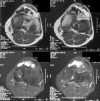Large infrapatellar ganglionic cyst of the knee fat pad: a case report and review of the literature
- PMID: 21816058
- PMCID: PMC3170344
- DOI: 10.1186/1752-1947-5-351
Large infrapatellar ganglionic cyst of the knee fat pad: a case report and review of the literature
Abstract
Introduction: Large ganglionic cystic formations arising from the infrapatellar fat pad are quite uncommon and only a few are mentioned in the literature. An open excision in these cases is mandatory.
Case presentation: We report the case of a large infrapatellar fat pad ganglion in a 37-year-old Greek man with chronic knee discomfort. The ganglionic cyst originated from the infrapatellar fat pad and had no intrasynovial extension. The final diagnosis was determined with magnetic resonance imaging of the knee, and the lesion was treated with surgery.
Conclusions: These lesions are asymptomatic in most cases but often are misdiagnosed as meniscal or ligamentous lesions of the knee joint. Nowadays, the therapeutic trend for such lesions is arthroscopic excision, but when there is a large ganglion, as in this case report, the treatment should be an open and thorough resection. This report is intended mostly but not exclusively for clinical physicians and radiologists.
Figures








References
-
- Bui-Mansfield LT, Youngberg RA. Intraarticular ganglia of the knee: prevelance, presentation, etiology and management. Am J Roentgenol. 1997;168:123–127. - PubMed
-
- Kaempffe F, D'Amato C. An unusual intra-articular ganglion of the knee with interosseous extension; a case report. J Bone Joint Surg Am. 1989;71:773–775. - PubMed
LinkOut - more resources
Full Text Sources

